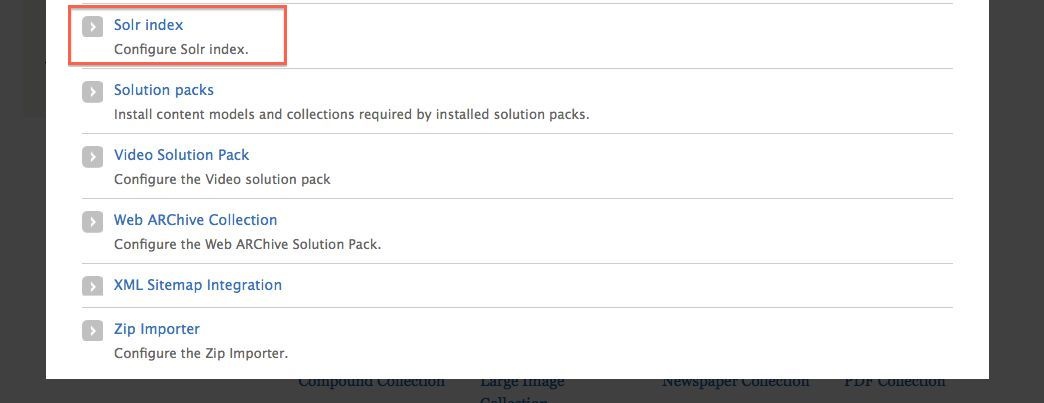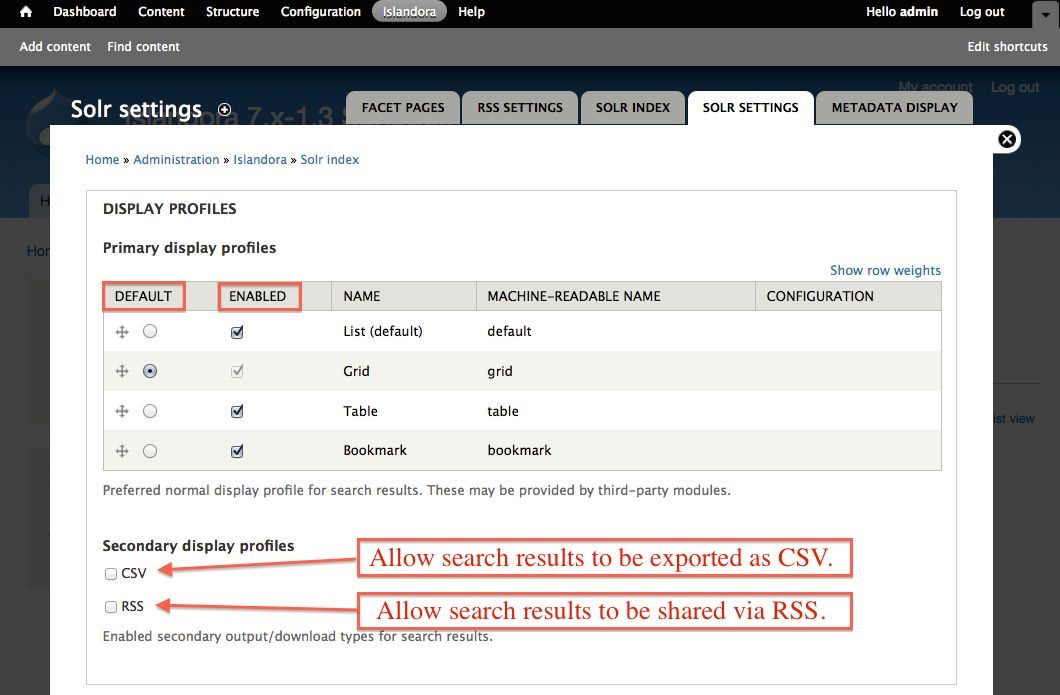| Section |
|---|
| Column |
|---|
Islandora uses Solr, in combination with Fedora's GSearch, to provide search functions to users on your site. This chapter assumes either: a) You are using the Virtual Machine Image, or are exploring Islandora via Sandbox (where Solr is already installed and configured) b) Solr and Gsearch are installed (following the instructions in Chapter 8 - Installing Solr and GSearch), and you have installed and activated the Solr module. The xslt and solrschema.xml documents that come packaged with GSearch should be used in configuration. These files are designed to work with our solution packs. Guidance for creating customizations to Solr are provided in the Customizing GSearch and Solr section. |
|
...
What is Solr? And why does Islandora use it?
Solr makes it easy to create advanced search features in Islandora, like faceting (arranging search results in columns with numerical counts of key terms). The following comes from the Solr guide; a link to the guide is provided in the Selected Reading section of this guide:
...
| Panel |
|---|
| title | To Recap: |
|---|
| borderStyle | solid |
|---|
|
- Solr makes digital assets in your Islandora installation discoverable. Solr helps to enable the display/searching of your digital assets' metadata.
- To index Fedora content in Solr, Islandora currently relies on Fedora's Gsearch.
- When going through the Islandora installation process, there is an xslt and solrschema.xml document that come packaged with GSearch that can be used out-of-the-box or customized to suit your repository's needs.
- GSearch uses the xslt to transform a Fedora FOXML document into a Solr xml document.
- solrchema.xml controls how Solr indexes xml files.
- FOXML files are simple xml files that directly expresses the Fedora Digital Object Model. FOXML is similar to METS as it is basically an xml container.
|
Solr “Out of the Box”
The Solr module comes with support for simple Dublin Core and simple MODS (i.e. no qualified fields!) searching and faceting to support our solution packs.
Solr Configuration
Solr Blocks
When Solr is installed, six additional blocks appear under your site's Structure>Blocks section:
...
By placing these blocks in regions of your site and configuring the Solr module under Islandora>Solr client, you can facilitate both full-text searching and faceted searching of items ingested using Solution Packs. The basic configuration of Solr can be modified to change the weight of search fields, and extend the out-of-the-box functionality.
Initial Solr Set Up
In order for Solr to work for your collections, you will have to activate the blocks that you want (see above), and configure them to display your desired results.
The following instructions will show you how to configure the initial Solr set up in your Islandora instance. Additional information about installing Solr and how Islandora uses Solr is provided in Installing Solr and GSearch.
1. Navigate to Solr Configuration Panel
Start by going to the ‘Islandora’ page in the admin panel and click on the ‘Solr Index’ link.

2. Verify the Solr URL and Request Handler
The Solr URL should be ip.address.of.site:port/solr. So, for example, if you’re using the Islandora Virtual Machine Image or another a local installation it should be localhost:8080/solr. If the URL is correct you will see a green check mark.
...
Make sure the request handler is set to ‘standard’. You can customize the request handler by editing solrconfig.xml to make other request handlers available. This assumes that you are using the default request handler, which will support all the metadata in our solution packs.
3. Set the Default and Secondary Display Profiles
You can modify the way search results are displayed by configuring the Display Profiles. You can choose from List, Bookmark, Grid (set to Default in the screenshot below), and Table. Secondary display profiles provide optional secondary outputs for search results. Switching back and forth between different display profiles is simple, so feel free to experiment and see which default display profile best suits your site. The display profiles appear on your site through the "Islandora displays" block, mentioned above.
Out-of-the-box, support for RSS and CSV output is also provided. Selecting these options will place an RSS feed and CSV button next to your search results.

4. Choose Search Terms in Advanced Search Block
Here you can choose the search terms that will appear in the drop-down menus on the advanced search block. Terms must be entered by their field names (in most cases this will be Dublin Core, but you can also use MODS), though you can optionally specify a more human-readable label with the configure option. To determine the appropriate syntax for your search terms, simply edit the metadata on any object in your repository (for instructions, see How to Edit an Object’s Metadata in Getting Started with Islandora). Each field label will display the proper syntax for adding it to your Solr search configuration. A full list of the terms made available by the schema provided in the module package is provided in APPENDIX D - SOLR SCHEMA (SEARCH) Term Reference.
...
| Info |
|---|
Solr field permissions are dependent on a role having Drupal permissions to search the Solr index. Roles without this permissions may appear in this list, but they will not be selectable. |
5. Choose Facet Fields
Solr uses faceting to filter search results. Here, you can choose which fields you wish to allow faceting on. The format is the same as the search terms described above. You can also use this screen to configure:
...
Note that you will want to use terms here that have been indexed as “strings”. Read APPENDIX D - SOLR SCHEMA (SEARCH) Term Reference for more information.
6. Choose Sort Fields
Using the same field formatting as Advanced Search and Faceting fields, you can select fields to make available to the user to sort their search results in the Sort block.
...
| Info |
|---|
The field for a relevance based sort is "score". |
7. Set Query Defaults
This section of the configuration panel provides advanced Solr query customization options:
...
You may wish to now use the Islandora Solr Metadata module to configure your site's Metadata Display - find out more in Islandora Solr Metadata Display.
| Info |
|---|
| title | Read more about Solr |
|---|
|
Consult the Solr Reference Guide to read more about Solr: https://cwiki.apache.org/confluence/display/solr/Apache+Solr+Reference+Guide |
Accessing Solr outside of the Islandora User Interface
You may find it useful to know that you can access Solr, and GSearch in your browser, as well as through your server.
...


